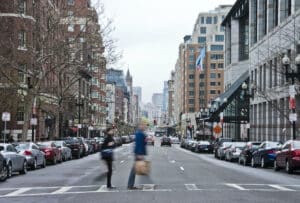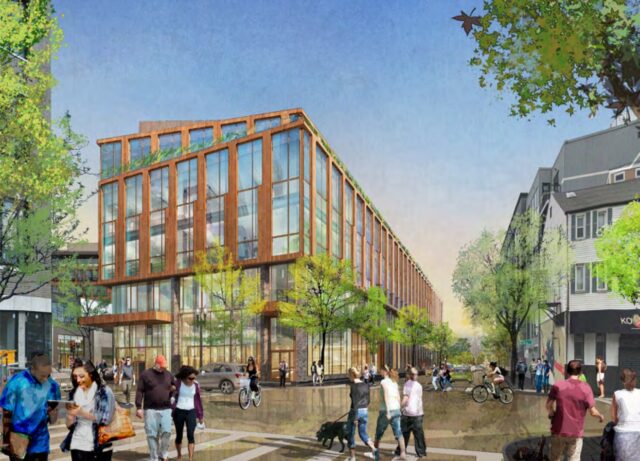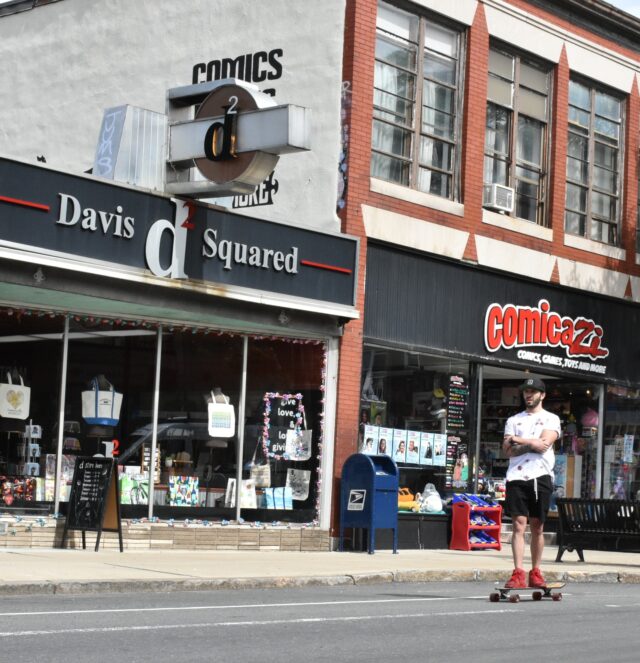
Two prime properties in the heart of Boston could become available to private developers if the Baker administration gets it way in selling the Hynes Convention Center in Back Bay, right, and Hurley state offices on Staniford Street. Photo courtesy of Joe Baz / CC BY 2.0
Greater Boston’s booming real estate industry continues to reshape the local landscape as the real estate cycle passes the decade mark, and 2020 is likely to generate more headlines about how developers are responding to the region’s job growth and housing needs.
State Seeks to Sell Hynes and Hurley Properties
The proposed sale of two state-owned properties sets the stage for potential battles in the state legislature and historical preservation circles, and the potential for a pair of large-scale developments in the heart of Boston.
Gov. Charlie Baker is pushing for the sale of the Hynes Convention Center in Back Bay and the Charles F. Hurley Building near Government Center, citing a chance to score a big payday for state coffers while encouraging economic development on two prime parcels.
Proceeds from the Hynes sale would offset a proposed $500 million expansion of the Boston Convention and Exhibition Center and requires legislative approval. But the plan is under fire from Back Bay businesses and developers who say the facility and its annual 500,000 visitors are vital to the local economy. Both the Back Bay Association and Massachusetts Convention Center Authority have commissioned economic impact studies, and the neighborhood business group is asking that any redevelopment be required to include 150,000 square feet of meeting space.
What do industry leaders see coming in the year ahead? Twelve commercial real estate market watchers offered us their predictions.
The property is expected to draw widespread interest from major developers.
“A lot of times in government, you can have an aversion to taking a risk,” said Michael Fallon, president of Boston-based Fallon Co. “The ability for the state and city to look at the Hynes as an opportunity is to be commended, because there’s a lot of users who could do something special there, and we’d certainly love to take a look at it.”
At the same time, the administration is preparing to seek redevelopment proposals for the Hurley state offices at 19 Staniford St., saying the property needs up to $200 million in repairs. The 3.25-acre property is zoned for buildings ranging up to 400 feet, but preservationists will have a say in its future. The complex includes the Lindemann Mental Health Center, designed by renowned Brutalist architect Paul Rudolph, and falls under the review of the Massachusetts Historical Commission, potentially posing roadblocks to significant changes.

As the life science industry expands in South Boston with projects like Anchor Line Partners and Alexandria Real Estate Equities’ 99 A St., pictured, Gillette’s nearby factory gains more and more redevelopment potential. Image courtesy of Elkus Manfredi
Gillette Campus Could Be Redeveloped
Gillette launched a facilities assessment of its World Shaving Headquarters in South Boston along with its 150-acre North Andover property.
The 34-acre South Boston campus is virtually surrounded by development, with nearby parcels selling for record prices in the past year as the life science industry expands along the A Street corridor. Gillette said it is seeking to build a “cutting-edge innovation center” and modernized office space and will maintain a significant presence in South Boston.
With its large surface parking lots, the property has significant potential for additional development.
Rezoning for Growth in Allston, Alewife and Somerville
Neighborhoods in Boston and Cambridge that are in heavy demand among commercial developers could be rezoned by higher density, while Somerville passed a citywide rezoning after seven years of debate.
The Boston Planning & Development Agency launched a Western Avenue planning study to guide future growth of the Allston corridor, where Harvard Allston Land Co. and life science developer King Street Properties are planning large projects. The study also will encompass the 176 Lincoln St. parcel where Harvard and Berkeley Investments are partnering on a redevelopment of the long-vacant Boston Tech Center.

A citywide rezoning could bring taller buildings with much lower parking requirements to Davis Square, following high-profile buys by British student housing specialist Scape and North Carolina retail developer Asana Partners. Photo by Ian Murphy for Banker & Tradesman
Somerville passed its first citywide rezoning overhaul since 1990, including reduced parking ratios and taller building heights in Davis Square. National developers including British student housing specialist Scape and North Carolina retail developer Asana Partners made major acquisitions in Davis Square in 2019, signaling potential redevelopment proposals and changes to the neighborhood’s retail scene.
Somerville’s approach is a stark contrast to Boston’s outdated zoning code which requires nearly all projects to seek zoning variances, said Ben Wan, an associate at Boston-based RODE Architects.
“This levels the playing field for new projects to approach discussions with their host neighborhood already knowing what is acceptable to the city, which should ease some tensions and enable more meaningful dialogue in the approvals process,” Wan said.
And as multifamily and life science developers continue to acquire properties in West Cambridge, the city released its Alewife District Report which recommends rezoning portions of the industrial Quadrangle neighborhood off Concord Avenue for mixed–use and multifamily projects. Without waiting for the outcome, Boston-based Cabot, Cabot & Forbes has proposed a 1.1 million-square-foot redevelopment of the Mabardy Washed Sand & Gravel property on Mooney Street including offices, labs and multifamily housing.
Boston Gets Serious About Resiliency
With neighborhoods that contain some of the city’s most valuable real estate increasingly subject to frequent flooding, Boston moved toward mandatory resiliency requirements for new developments and renovations.
The Boston Planning and Development Agency approved new design guidelines for coastal resilience in October, which will be included in a new overlay zoning district governing new development and retrofits. Boston Mayor Marty Walsh signed a new wetlands ordinance sponsored by City Councilors Matt O’Malley and Michelle Wu on Dec. 23. The ordinance establishes new flood resilience zones based upon projected sea level rises in 50 years.
At the same time, the BPDA is coordinating the city’s plans for a 6-foot-tall elevated berm along Fort Point Channel with developers Related Beal, National Development and Alexandria Real Estate Equities, which recently acquired parcels in the flood-prone district. And the city’s Green Ribbon Commission is studying potential district-wide financing methods to pay for long-term coastal defenses that are estimated to cost $1 billion in South Boston and the Seaport District alone.
New Support for Baker Housing Bill

Steve Adams
Boston has played an outsized role in the region’s recent housing production, permitting more than 30,000 units since 2011. More than half of the state’s multifamily housing approved from 2013 to 2017 was in Boston, Cambridge, Everett and Watertown, according to a June report by housing activists.
To break down local communities’ barriers to development, Gov. Charlie Baker has lobbied on behalf of his Housing Choice Bill which would make it easier for developers to obtain zone changes for multifamily housing.
The bill lingered in the legislature’s Joint Housing Committee throughout the year. With a Jan. 31 deadline to report the bill to the full House of Representatives, the housing committee in late December was reportedly nearing a potential vote.




 |
| 
